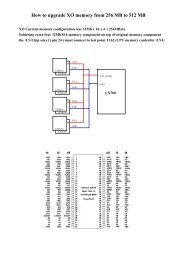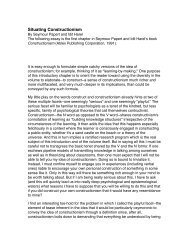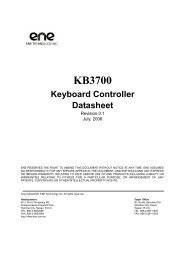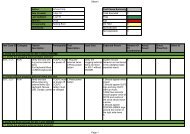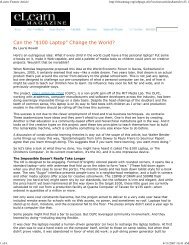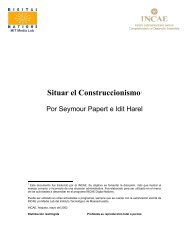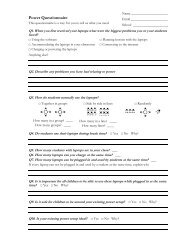NAND Flash Memory MT29F4G08AAAWP ... - Micron
NAND Flash Memory MT29F4G08AAAWP ... - Micron
NAND Flash Memory MT29F4G08AAAWP ... - Micron
- No tags were found...
Create successful ePaper yourself
Turn your PDF publications into a flip-book with our unique Google optimized e-Paper software.
4Gb, 8Gb, and 16Gb x8 <strong>NAND</strong> <strong>Flash</strong> <strong>Memory</strong>Command DefinitionsREAD STATUS 70hThese <strong>NAND</strong> <strong>Flash</strong> devices have an 8-bit status register the software can read duringdevice operation. Table 9 describes the status register.After a READ STATUS command, all READ cycles will be from the status register until anew command is issued. Changes in the status register will be seen on I/O[7:0] as longas CE# and RE# are LOW; it is not necessary to start a new READ STATUS cycle to seethese changes.In devices that have more than one die sharing a common CE# pin, the READ STATUS(70h) command reports the status of the die that was last addressed. If interleaved operationsare started on both die, then the TWO-PLANE/MULTIPLE-DIE READ STATUS(78h) command must be used to select the die that should report status. In this situation,using the READ STATUS (70h) command will result in bus contention, as both diewill respond until the next operation is issued.While monitoring the status register to determine when the t R (transfer from <strong>NAND</strong><strong>Flash</strong> array to data register) is complete, the user must reissue the READ (00h) commandto make the change from status to read mode. After the READ command has been reissued,pulsing the RE# line will result in outputting data, starting from the initial columnaddress.Table 9:Status Register Bit DefinitionSRBitProgramPageProgram PageCache ModePage ReadPage ReadCache Mode Block Erase Definition0 1 Pass/fail Pass/fail (N) – – Pass/fail 0 = Successful PROGRAM/ERASE1 = Error in PROGRAM/ERASE1 – Pass/fail (N-1) – – – 0 = Successful PROGRAM1 = Error in PROGRAM2 – – – – – 03 – – – – – 04 – – – – – 05 Ready/busy Ready/busy 2 Ready/busy Ready/busy 2 Ready/busy 0 = Busy1 = Ready6 Ready/busy Ready/busycache 3 Ready/busy Ready/busycache 3 Ready/busy 0 = Busy1 = Ready7 Write protect Write protect Write protect Write protect Write protect 0 = Protected1 = Not protectedNotes:1. Status register bit 0 reports a “1” if a TWO-PLANE PROGRAM PAGE or TWO-PLANE BLOCKERASE operation fails on one or both planes. Status register bit 1 reports a “1” if a TWO-PLANE PROGRAM PAGE CACHE MODE operation fails on one or both planes. Use TWO-PLANE/MULTIPLE-DIE READ STATUS (78h) to determine the plane to which the operationfailed.2. Status register bit 5 is “0” during the actual programming operation. If cache mode is used,this bit will be “1” when all internal operations are complete.3. Status register bit 6 is “1” when the cache is ready to accept new data. R/B# follows bit 6.See Figure 19 on page 29 and Figure 73 on page 77.PDF: 09005aef81b80e13/Source: 09005aef81b80eac<strong>Micron</strong> Technology, Inc., reserves the right to change products or specifications without notice.4gb_nand_m40a__2.fm - Rev. B 2/07 EN 26 ©2006 <strong>Micron</strong> Technology, Inc. All rights reserved.



